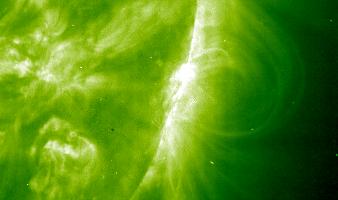--2005--
Voyages
to the Sun (NASA- "Why We Explore")- December 2, 2005
Humanity's epic voyages to the Moon are well known, the stuff of
history. But what about voyages to the Sun? Though they do not involve
human spacecraft, those voyages are no less epic. And on the occasion
of the tenth anniversary of the launch of one of the most successful
voyages — is the Solar and Heliospheric Observatory, fondly
known as SOHO — it is fitting that we recall those voyages
to our life-giving star.
 Intrepid
Solar Spacecraft Celebrates 10th Anniversary (NASA Feature)-
November 29, 2005
Intrepid
Solar Spacecraft Celebrates 10th Anniversary (NASA Feature)-
November 29, 2005
The Solar and Heliospheric Observatory (SOHO) spacecraft celebrates
its 10th anniversary December 2. The SOHO mission, a collaboration
between NASA and the European Space Agency (ESA), has allowed scientists
to make significant advances in understanding the closest star,
our sun.
Sickening
Solar Flares (NASA press release)- November 8, 2005
When the biggest solar proton storm in 15 years erupted in January,
many were left wondering: what would have happened if astronauts
were on the moon?
An
Odd List of Body Parts (NASA press release)- October 26, 2005
Researchers are making a list: Which parts of an astronaut are most
sensitive to solar flares?
NASA's
Telescope for Students Reveals Record Solar Explosion Even More
Powerful (NASA press release)- October 14, 2005
Astronomers using an inexpensive NASA radio telescope kit for students
discovered that the record solar flare on November 4, 2003 was even
more powerful than originally estimated.
Who's
Afraid of a Solar Flare? (NASA press release)- October 7, 2005
Solar activity can be surprisingly good for astronauts.
Spacecraft
Pick up Earthly Aurora (NASA press release)- September 9, 2005
A coronal mass ejection (CME) hit Earth's magnetic field on Sept.
15, but it did not spark the strong display of auroras many people
were hoping to see. In the CME's wake, however, a fast solar wind
stream is blowing past Earth and buffeting our planet's magnetic
field. This could cause mild geomagnetic storms.
Huge
Solar Flares Continue (NASA press release)- September 7, 2005
Scientists are currently tracking a large sunspot that has so far
unleashed seven major solar flares including an X-17-category blast
on Sept. 7, an X-5 on Sept. 8, and an X-1 on Sept. 9. To say this
is powerful is an understatement; Wednesday's X-17 flare was the
fifth largest ever observed.
 Double
Solar Flare
(NASA feature)- August 22, 2005
Double
Solar Flare
(NASA feature)- August 22, 2005
Yesterday, Aug. 22, a pair of coronal mass ejections (CMEs) blasted
off the Sun and headed toward Earth. Geomagnetic storms and auroras
are possible today, Aug. 23 and tomorrow, Aug. 24 in Alaska and
Canada and possibly beyond.
Utah
bathed in pretty pink Aurora (The Register Article)-
August 22, 2005
Stargazers in Utah, Colorado, New York and other US states were
treated to a rare display in the early hours of this morning, when
the first of two large coronal mass ejections from the Sun collided
with the Earth's atmosphere, creating stunning Auroras.
Scientists
One Step Closer to Forecasting 'Clear Skies' for Astronauts
(NASA feature)- August
16, 2005
Scientists funded by NASA's Living With a Star program have
made a big stride forward in learning how to forecast "all
clear" periods where severe space weather is unlikely.
 Sun's
Temper Blamed for Arctic Ozone Loss (Live Science Article)-
March 1, 2005
Sun's
Temper Blamed for Arctic Ozone Loss (Live Science Article)-
March 1, 2005
A dramatic thinning of Earth's protective ozone layer above the
Arctic last year was the result of intense upper-level winds and
an extra dose of space weather, scientists said Tuesday.
Sickening
Solar Flares - January 27, 2005
The biggest solar proton storm in 15 years erupted last week.
NASA researchers discuss what it might have done to someone on the
Moon.



 Double
Solar Flare
Double
Solar Flare Sun's
Temper Blamed for Arctic Ozone Loss
Sun's
Temper Blamed for Arctic Ozone Loss